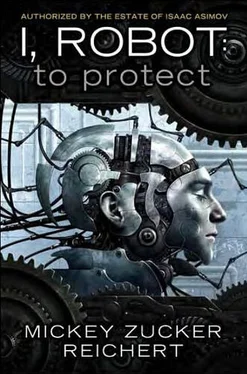The sister’s head was bobbing. Dad crossed his arms on his chest. Mom studied the screen.
“The nanorobots will be left in place for two weeks, during which time they will gather information about the chemical and neurological processes occurring in Payton’s brain. At that point, we will remove the nanorobots via another lumbar puncture. We will then insert them into a special computer, which will help us target appropriate therapies to assist with Payton’s mental health issues. In this case, schizophrenia.”
Susan could hear herself adopting the neutral voice common to all doctors while explaining a complicated procedure to laymen. “Risks include discomfort during the lumbar punctures and the possible introduction of bacteria or viruses, which I will minimize with sterile procedure. As we discussed, the nanorobots should not theoretically cause either rejection or foreign body reaction, but a small risk still exists for either of these. As with any procedure, minimal but possible risks include death, debilitation, or worsening of the problem.”
The mother laughed nervously. “You certainly do cover all the bases.”
It seemed ludicrous to Susan, too; but aggressive lawyers always spurred greater caution, sometimes to a ridiculous extreme. Manufacturers even plastered warnings on their boxes such as CAUTION: HOT WHEN HEATED. “Do you have any questions?”
The mother shook her head, but Payton’s sister piped right in. “What’s to prevent these nanobots from escaping into the rest of his body? What if they get loose . . . into the food supply or something?”
Susan appreciated the question. It meant at least one member of the family had a full understanding of her explanation. “There’s a semipermeable system of endothelial cells in the brain that separates the cerebrospinal fluid from the circulatory system. We call it the blood brain barrier. Most of the time, its job is to keep dangerous things out of the brain: bacteria, foreign substances, body hormones, dyes, most medications. In fact, it’s what makes brain infections both rare and hard to treat; most antibiotics can’t cross it, either. These nanorobots were manufactured with the blood brain barrier in mind. They’re too large to slip through, completely fat-insoluble so they can’t diffuse through, and also highly charged. Radiation can break down the blood brain barrier, so their tags are deeply inserted.” Susan knew she had gotten too technical. “In other words, it’s not possible for these nanorobots to get out of the patient’s brain except by lumbar puncture.”
The parents sat silently, but the daughter had one more question. “And when you remove them, how do you know you got them all?”
“Good question.” The sister clearly was paying attention. “When we perform the second lumbar puncture, we use a small magnetic device to draw the nanorobots. Another device keys onto the radioactive markers to ensure we don’t leave anything behind. If any of the nanos get stuck, we only need to reposition your brother in such a way as to free it. On his side, his back, standing. I’ll make sure they’re all in the right place before performing the lumbar puncture. Even if one did get left behind, it’s inert. It would simply flow around with the cerebrospinal fluid, taking in data forever.”
Susan could only imagine the reactions at USR to having one of their ten-thousand-dollar robots lost in a schizophrenic brain for a lifetime. For the patient, however, it would not prove a danger.
Finally, the mother found a question. “What about the radiation?”
Susan reassured her. “It’s just a tag and deeply buried in the nanorobots. It won’t affect your son directly.” She handed the palm-pross to Mrs. Flowers.
The woman stared at the screen, rereading everything Susan had elaborated. She seemed reluctant to sign. “Dr. Calvin, there’s a chance this could kill Payton, right? Or he could develop a brain infection that might make things even worse than they are now.”
Susan dared not lie, even to pacify a worried mother. During her M-4 pediatrics rotation, she had watched a panicked mother beg absolutes from a tenderhearted resident. The routine nature of the surgery gave the resident leeway to say the chance of death was as close to zero percent as anything ever got. The procedure had gone fine, but an atypical sensitivity reaction to the anesthesia had resulted in a massive heart attack that killed the patient. It was the kind of thing no one could have foreseen, but the parents felt betrayed, and the resident had slid into a deep depression. “A very small chance, yes. Unfortunately, nothing in life is wholly without risk, and an experimental procedure is more dangerous than, say, eating a meal in a fast food restaurant or taking a shower. Yet people do die of those things, too.”
Susan had no intention of talking this family into the procedure. If they refused, Goldman and Peters would simply find another desperate patient. Schizophrenia affected one percent of the world’s population. Current procedures cured nearly fifty percent, and all but about five percent of the chronic patients responded at least tolerably well to some form of medication. That still left a million and a half possible replacements for Payton Flowers.
When the mother still did not sign, her daughter stepped in. “Ma, how many times have you secretly wished the fall from the roof had killed Payton? At least then we could remember him as the bright, generous boy he had been until that day. The horror of the last few years wouldn’t clutter and cloud those memories.”
Mrs. Flowers jerked toward her daughter, an appalled look on her face. “I’ve never said that.”
“No,” the daughter concurred. “But you’ve thought it. We’ve all thought it.”
The mostly silent father nodded.
“You’ve thought it, too?” Mrs. Flowers choked out. Tears turned her eyes shiny.
Susan stepped in. “It’s a perfectly normal reaction. People who don’t live with mental illness day in and day out can’t understand the agony. It’s why most mental illnesses have a standard ten percent suicide rate, and that’s with all our modern forms of treatment. A recent survey of the inmates of a top psychiatry inpatient hospital found that eighty-six percent of them would trade their current diagnoses for terminal cancer.” She had read it in Psychiatry only the previous month.
Susan had meant the words to console the mother, to make her feel less guilty for the thoughts her daughter had elicited. Instead, the two women sobbed in each other’s arms.
The father grabbed the palm-pross and signed his name with a flourishing finger. Clearly the practical one in the family, he rose from his seat. “Now, Doc, how would you like me to hold him?”
Susan Calvin did not return to the PIPU until well into the afternoon. Keyed through the doors, she rushed onto the unit to receive glares from most of the staff. Uncertain what she might have done, she ignored them and headed for the staffing area to read the nurses’ notes on her patients. If anything had happened that day, someone should have keyboarded it into permanent history.
Sharicka’s day seemed to have consisted mostly of begging for human helicopter and horsey rides, though one note documented a near flood in the girls’ bathroom that was traced back to the girl. Apparently, Sharicka had “accidentally” left a wadded towel in the sink and the tap wide open. At least, this time, no alternative possibilities for the crime had been postulated. It seemed like a step in the right direction for the manipulated nursing staff.
Sable looked up from a palm-pross to give Susan a squint-eyed look that baffled her. Ignoring her, Susan glanced over Monterey’s notes, but the hostility stayed with her. She had never had a problem with Sable before. Monterey’s nursing notes contained nothing of interest. The girl remained uncommunicative, verbally and mostly nonverbally as well. The only new mention concerned a car-shaped gurney that had arrived from the pediatrics unit.
Читать дальше












